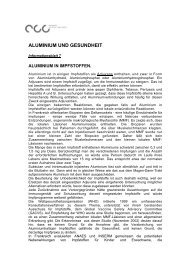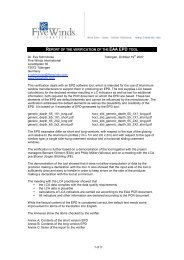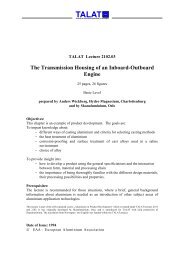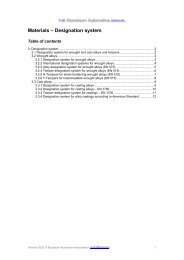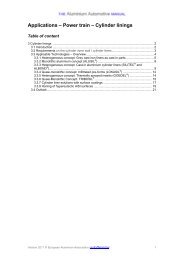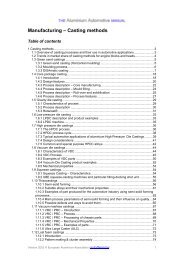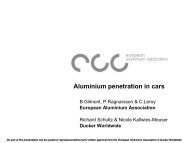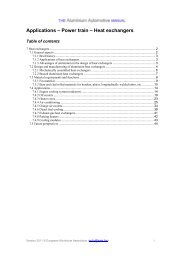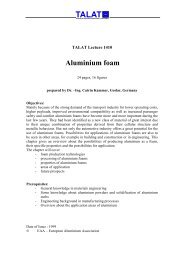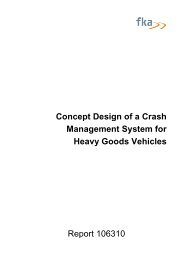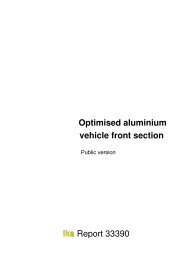aluminium in commercial vehicles - European Aluminium Association
aluminium in commercial vehicles - European Aluminium Association
aluminium in commercial vehicles - European Aluminium Association
You also want an ePaper? Increase the reach of your titles
YUMPU automatically turns print PDFs into web optimized ePapers that Google loves.
EUROPEAN ALUMINIUM ASSOCIATION ALUMINIUM IN COMMERCIAL VEHICLES CHAPTER VI 59<br />
4. Alum<strong>in</strong>ium versus Steel<br />
Both steel and <strong>alum<strong>in</strong>ium</strong> are<br />
metals with relatively high<br />
strength. Both materials are<br />
<strong>in</strong>combustible and will not contribute<br />
to a fire. For structural<br />
purposes the ma<strong>in</strong> differences<br />
are:<br />
Elasticity: The modulus of elasticity<br />
(E-modulus) of <strong>alum<strong>in</strong>ium</strong> is<br />
1/3 of that of steel. This means<br />
that an <strong>alum<strong>in</strong>ium</strong> beam with<br />
the same cross-section and the<br />
same loads as a steel beam will<br />
have a deflection 3 times that of<br />
the steel beam.<br />
Weight: The density of <strong>alum<strong>in</strong>ium</strong><br />
is 1/3 of that of steel. This<br />
means that a steel beam will<br />
weigh 3 times more than an <strong>alum<strong>in</strong>ium</strong><br />
beam with the same<br />
cross-section.<br />
Weld<strong>in</strong>g: When weld<strong>in</strong>g a hardened<br />
<strong>alum<strong>in</strong>ium</strong> alloy some of<br />
the harden<strong>in</strong>g effects will be lost.<br />
The strength <strong>in</strong> the heat affected<br />
zone (HAZ) will be reduced. This<br />
reduction depends on the alloy,<br />
temper, type of product and<br />
weld<strong>in</strong>g procedure. Ord<strong>in</strong>ary<br />
steel has no strength reduction<br />
after weld<strong>in</strong>g.<br />
Thermal elongation: The coefficient<br />
of thermal elongation of<br />
<strong>alum<strong>in</strong>ium</strong> is twice that of steel.<br />
This means that an <strong>alum<strong>in</strong>ium</strong><br />
member will get twice the thermal<br />
elongation as a similar steel<br />
member with the same temperature<br />
difference. S<strong>in</strong>ce the elastic<br />
modulus of <strong>alum<strong>in</strong>ium</strong> is 1/3 of<br />
steel, the stresses <strong>in</strong> an <strong>alum<strong>in</strong>ium</strong><br />
member with fixation are 2/3 of<br />
that <strong>in</strong> a similar steel member.<br />
Most of the structural <strong>alum<strong>in</strong>ium</strong><br />
alloys have relatively high<br />
“strength-to-E modulus” ratio.<br />
This effect is especially clear<br />
when the <strong>alum<strong>in</strong>ium</strong> alloy is<br />
stra<strong>in</strong>-hardened or heat-treated.<br />
Structural <strong>alum<strong>in</strong>ium</strong> alloys have<br />
roughly twice the “strength-to-E<br />
modulus” ratio than standard steel.<br />
However, when compared with<br />
high strength steels, structural<br />
<strong>alum<strong>in</strong>ium</strong> alloys have about the<br />
same “strength-to-E modulus”<br />
ratio. It should also be noted that<br />
the elastic modulus of an alloy<br />
ma<strong>in</strong>ly depends on its parent<br />
metal. In other words, all <strong>alum<strong>in</strong>ium</strong><br />
alloys have very similar Emodulus,<br />
but this is also valid for<br />
steel alloys. Consequently, the so<br />
called “high strength steels”<br />
don’t have better elastic properties<br />
than mild steel.<br />
Steel designers often use the<br />
strength of the material as govern<strong>in</strong>g<br />
criteria when desig n<strong>in</strong>g a<br />
steel struc ture and check afterwards<br />
whether the deflection is<br />
with<strong>in</strong> the requirement.<br />
When design<strong>in</strong>g an <strong>alum<strong>in</strong>ium</strong><br />
structure, it will often be the<br />
deflection criterion that will be<br />
govern<strong>in</strong>g. For that reason, the<br />
design procedure will start with<br />
the deflection criterion and it will<br />
be checked afterwards if the<br />
stress or the resistance of the<br />
structure is with<strong>in</strong> the limits.<br />
The deflection of members under<br />
bend<strong>in</strong>g load depends on the<br />
modulus of elasticity (E) and on<br />
the moment of <strong>in</strong>ertia (I) together<br />
with the load and the span.<br />
With the same span and load, it<br />
will be the product E x I that will<br />
determ<strong>in</strong>e the deflection.<br />
To get the same deflection of<br />
steel and <strong>alum<strong>in</strong>ium</strong> beams <strong>in</strong><br />
bend<strong>in</strong>g, the moment of <strong>in</strong>ertia<br />
of the <strong>alum<strong>in</strong>ium</strong> beam must be<br />
three times that of steel. If the<br />
<strong>in</strong>crease <strong>in</strong> the moment of <strong>in</strong>ertia<br />
is to be done only by <strong>in</strong>creas<strong>in</strong>g<br />
the thickness of the web and<br />
flanges, the <strong>alum<strong>in</strong>ium</strong> beam will<br />
have the same weight as the<br />
steel beam.



